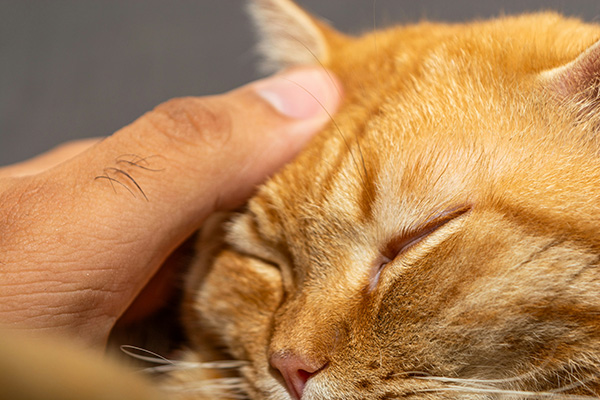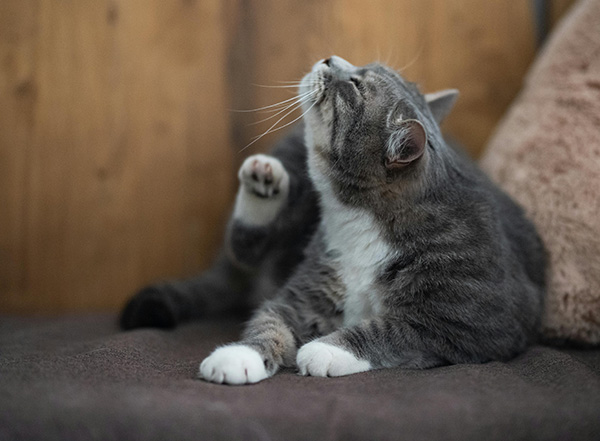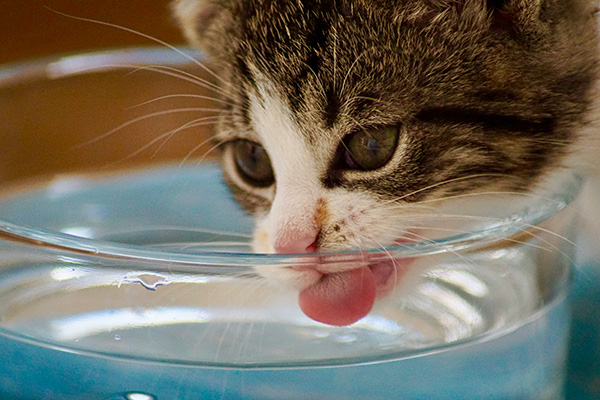Dry skin in cats is a common yet uncomfortable issue that can arise from several factors, including environmental conditions and underlying health problems. Environmental factors, such as dry air and temperature changes, can cause a cat's dry skin by depleting moisture, leading to flaky skin and itchy skin. Additionally, underlying health conditions like allergies, nutritional deficiencies, and systemic diseases can cause dry skin, resulting in irritated skin and making it essential for pet parents to recognize and address these issues to promote healthy skin and prevent discomfort.
Identifying the symptoms and understanding the causes can aid in effectively managing and preventing dry skin in your cat. In this article, we’ll cover everything you need to know about dry skin in felines, including what to watch for and how to treat it.
What is Dry Skin in Cats
Dry skin in cats is a condition where the skin becomes flaky, irritated, and lacking in moisture, which can lead to discomfort for your feline. Just like humans, cats can experience dry skin for various reasons, and it often presents as dandruff-like flakes in their fur, itchiness, and irritation. Cats with dry skin may scratch more frequently, lick or bite at affected areas, and their coat might lose their usual shine or feel coarse.
Causes of Dry Skin in Cats

Environmental Factors
Dry indoor air, particularly during winter months, can deplete moisture from a cat’s skin, leading to flaky skin and itchy skin. Heaters and lack of humidity contribute to this dryness, making it essential to monitor indoor air quality to prevent dry cat skin and maintain a healthy environment for your pet. Dry air not only affects the skin but also can exacerbate other symptoms such as mild itchiness and irritated skin.
Grooming Challenges
Obesity, arthritis, and other mobility issues can prevent cats from grooming properly, causing them to develop dry skin and other cat skin conditions. Without regular grooming, a cat’s skin can become dry and flaky as natural oils are not adequately distributed, leading to irritated skin and other associated symptoms. When a cat has dry skin, it’s often accompanied by other noticeable changes in the cat's fur and overall coat health.
Over-Grooming
Excessive licking and grooming due to discomfort or anxiety can worsen skin dryness, turning mild itchiness into more severe skin issues. Over-grooming often leads to the removal of essential oils, exacerbating dry skin conditions and making it harder to treat dry skin effectively. This behavior can lead to hair loss and expose the skin to bacterial and fungal infections, further complicating the cat's skin health.
Nutritional Deficiencies
An unbalanced diet lacking essential fatty acids and other nutrients can lead to dry skin, making the cat more prone to irritated skin and other skin conditions. A diet rich in omega-3 and omega-6 fatty acids is crucial for maintaining healthy skin and coat health, so ensuring your cat's food is well-balanced can prevent these issues and promote healthy skin. Poor diet and food allergies can also be the root cause of feline dandruff and flaky skin.
Frequent Bathing
Excessive bathing can remove the natural oils from a cat's skin, resulting in dryness and irritation. It’s important to bathe cats only when necessary and to use gentle, cat-specific shampoos to avoid developing dry skin from inappropriate bathing habits, which can exacerbate flaky skin and other cat skin conditions. Using an unsuitable shampoo can aggravate dry skin, causing more discomfort and necessitating proper treatment.
Parasites
Fleas, mites, and ticks can lead to skin irritation and dryness, resulting in issues like cat dandruff and itchy skin. Regular parasite control is crucial in preventing these issues and maintaining skin health, as conditions like flea allergy dermatitis can severely impact skin health if not addressed promptly. Flea dirt and walking dandruff are common indicators of parasitic infestations that require immediate attention to prevent severe skin infections.
Allergies
Common allergens like pollen, dust mites, food, and chemicals can cause dry skin in cats, leading to flaky skin and itchy skin. Identifying and avoiding these allergens can help in managing skin conditions and preventing flaky skin and other symptoms, ensuring your cat's sensitive skin remains healthy. Allergic reactions often manifest as dry cat skin, so addressing the underlying cause to improve your pet's health is essential.
Skin Diseases
Various skin diseases like psoriasis, seborrhea, and dermatitis contribute to dry skin and other cat skin conditions. Proper diagnosis and treatment are essential for these conditions to alleviate dryness and maintain a healthy coat, preventing the cat from suffering from hair loss and other issues. Fungal and bacterial infections can complicate skin diseases, requiring veterinary medicine to manage these conditions effectively.
Systemic Health Issues
Diseases such as diabetes, hyperthyroidism, and kidney disease can manifest as dry skin, leading to flaky skin and other related issues. Managing these underlying health conditions is crucial for improving skin condition and preventing further health complications, ensuring your cat's body remains in optimal health. These systemic issues can weaken the cat's immune system, making the cat more susceptible to skin infections and other health problems.
Symptoms of Dry Skin

Visible Flaking and Dandruff
Dandruff and flaky skin are primary indicators of cat dry skin. Observing the skin and coat for these signs can help detect and treat dry skin effectively. Feline dandruff can be an indicator of underlying cat skin conditions, including skin disease, bacterial and fungal infections, or food allergies. Regularly checking for flaky skin and addressing it promptly ensures that any underlying cause, such as nutritional deficiency, imbalanced diet, or skin irritation, is treated before it worsens. Pet parents should be aware that dry skin in cats might also be linked to environmental factors like dry air or the use of the wrong shampoo.
Itching and Scratching
Constant itching and scratching may indicate underlying dry skin problems. Monitoring your cat’s behavior is key to identifying potential cat skin conditions and ensuring timely intervention to treat dry skin. If you notice your cat regularly spending excessive time scratching or grooming, it could be a sign that your cat has dry skin. Addressing this behavior early can prevent further damage to the cat's fur and coat, promoting healthy skin and overall cat skin health. Conditions such as flea allergy dermatitis, sensitive skin, or fungal infections can exacerbate itchy skin and should be checked by a veterinarian to provide proper treatment.
Unkempt Coat Appearance
An unkempt coat, such as dullness and brittleness, is often associated with cat's dry skin. Regular grooming can help in keeping the cat's coat healthy and shiny, promoting overall cat skin health. Ensuring your cat's environment is conducive to maintaining a healthy coat, such as providing a humidifier during dry seasons, can significantly improve their skin condition. Additionally, supplements like fish oil and aloe vera can support skin cells and coat health, contributing to a more vibrant appearance. A poor diet or imbalanced diet may lead to dry cat skin, so ensuring your cat's diet includes essential fatty acids and nutrients is vital. Pet parents should consult with their vet to identify any underlying health conditions or associated symptoms that might indicate feline dandruff or other symptoms of cat dry skin.
Home Remedies
Humidifiers
Adding humidifiers to your cat's environment can help treat dry skin by maintaining skin moisture, particularly during the winter months when dry air is common indoors. A more humid environment is essential in preventing your cat's dry skin from worsening, reducing the risk of flaky skin, and ensuring skin cells remain hydrated and healthy, which promotes healthy skin and overall cat skin health.
Add Omega-3 Fatty Acids to Their Diet
Omega-3 fatty acids, commonly found in fish oil, can help moisturize your cat’s skin from the inside out. These healthy fats possess anti-inflammatory properties and promote overall skin and coat health. You can add a small amount of fish oil (such as salmon oil) to your cat’s food, but make sure to check with your vet for the proper dosage to avoid over-supplementing. Some cat foods already contain omega-3s, so you may not need to supplement if your cat’s diet is already balanced.
Coconut Oil
Coconut oil is a well-known natural remedy for dry skin because of its moisturizing and anti-inflammatory benefits. You can apply a small amount to the dry patches on your cat’s skin, but be cautious not to use too much, as cats might groom themselves and ingest the oil. Coconut oil can also be added to their diet in small quantities (about 1/4 teaspoon) to improve skin hydration, but consult your vet before introducing it into their diet.
Regular Grooming
Regular brushing helps spread natural oils and remove dead skin cells, preventing the worsening of your cat’s dry skin. Grooming your cat regularly can improve coat condition, keep your pet's hair in top shape, and prevent issues related to a dry and unhealthy coat.
Oatmeal Baths
An oatmeal bath can soothe your cat’s dry, itchy skin. Oatmeal is renowned for its anti-inflammatory and moisturizing properties, making it an excellent natural remedy for dry skin. To prepare an oatmeal bath, grind plain oatmeal into a fine powder and mix it with warm water. Gently bathe your cat in the oatmeal-infused water, avoiding its head and eyes. Rinse thoroughly afterward and dry it completely to avoid moisture being trapped in its fur.
Olive Oil for Topical Use
Olive oil can be used to moisturize and soothe small dry patches of skin. Apply a small amount and gently rub it into the affected areas. Like coconut oil, olive oil is safe in small amounts, but ensure your cat doesn’t ingest too much as it may upset their stomach.
Hydration and Wet Food
Ensuring your cat is well-hydrated is one of the most important steps in preventing dry skin. Cats often don’t drink enough water, so switching to a high-quality wet food or incorporating more wet food into their diet can help increase their water intake. Wet food contains more moisture than dry kibble, which helps keep your cat hydrated and improves their skin and coat health.
Apple Cider Vinegar (Diluted)
Apple cider vinegar, when diluted with water, can act as a natural remedy for skin issues, including dryness. Combine equal parts apple cider vinegar and water, then lightly apply the mixture to the affected areas using a spray bottle or a cotton ball. Apple cider vinegar has antifungal and antibacterial properties, which can help soothe itchy skin, though it should not be applied to open wounds or severely irritated areas.
Aloe Vera for Irritated Skin
Aloe vera is recognized for its soothing and healing benefits. You can apply a small amount of pure, unscented aloe vera gel to any irritated or dry areas on your cat's skin. Be sure to use a product specifically labeled as safe for pets, as some aloe vera products may contain harmful additives to cats. Also, prevent your cat from licking the area, as ingesting aloe vera in large quantities can be toxic.
Medical Interventions
Consulting a vet to identify and treat the underlying causes of a cat's dry skin is essential for maintaining healthy skin cells and overall well-being. A professional diagnosis can guide effective treatment plans tailored to your cat's specific needs, addressing any underlying skin disease and ensuring the cat's environment supports their health.
Medicated Shampoos
Vet-recommended medicated shampoos can alleviate symptoms of dry skin by treating the specific skin conditions your cat may be experiencing. These shampoos are formulated to address underlying causes of skin issues and restore moisture, ensuring proper treatment of your cat's dry skin and preventing further irritation and hair problems.
Parasite Control
Consistent flea and tick prevention is essential for preventing skin irritation and promoting overall skin health. Maintaining a parasite-free environment helps keep the skin healthy. It prevents conditions like flea allergy dermatitis, ensuring your cat spends time in a safe and healthy environment and reducing the risk of noticing dry skin issues.
Preventative

Provide a Balanced, Nutrient-Rich Diet
A high-quality, balanced diet is crucial in preventing dry skin in cats. Make sure your cat's diet includes essential fatty acids such as omega-3 and omega-6, which are important for keeping the skin hydrated and fostering a healthy, shiny coat. These nutrients are commonly found in foods that are high in fish oils or flaxseed. You can supplement your cat’s diet with fish oil or other vet-approved supplements to boost their skin and coat health. Additionally, vitamins and minerals like zinc and vitamin E are important for skin regeneration. A nutrient-rich diet will support overall skin health and prevent dryness.
Ensure Proper Hydration
Proper hydration is essential in keeping your cat’s skin moisturized from within. Cats frequently do not drink enough water, so it's essential to promote hydration. Offering fresh water daily and placing several bowls around the house can be beneficial. Some cats prefer drinking from running water, so using a cat water fountain might encourage them to drink more. Including wet food in your cat’s diet is another great way to ensure they are getting adequate moisture, as wet food contains a higher water content compared to dry kibble.
Use a Humidifier
In colder months, indoor heating systems can reduce humidity in the air, potentially causing dry skin in cats. To address this issue, using a humidifier in the areas where your cat spends the most time can help retain moisture in the environment. This added humidity prevents their skin from becoming flaky and helps retain hydration, especially during winter when low humidity levels are common. Keeping the air properly humidified is an easy and effective way to prevent dry skin in cats.
Regular Grooming
Grooming your cat regularly is another key way to prevent dry skin. Combing your cat’s fur helps spread the natural oils from their skin, keeping both their skin and coat moisturized. Regular brushing also removes loose fur and dandruff, helping to prevent matting, which can trap dry skin underneath. Using the right grooming tools for your cat’s fur type ensures you don’t damage their sensitive skin while promoting healthy skin and a smooth, shiny coat.
Limit Bathing and Use Moisturizing Shampoos
Cats generally don't require regular baths since they are proficient at grooming themselves. However, when baths are necessary, using a cat-specific moisturizing shampoo is important. Human or dog shampoos can be too harsh for a cat’s skin and may strip away natural oils, causing dryness. Limiting baths to only when absolutely needed and using veterinarian-recommended shampoos will help hydrate your cat’s skin. Make sure to completely dry your cat after a bath to avoid moisture loss from their skin.
Control Parasites
Flea bites, mites, and other parasites can irritate a cat’s skin, leading to excessive scratching, which in turn can cause dry skin. To prevent this, it’s important to use regular flea prevention treatments and check your cat’s skin for any signs of parasites. Flea and tick preventatives prescribed by a vet will help keep your cat free from pests, thereby reducing the likelihood of skin irritation and dryness caused by allergic reactions to bites.
Manage Allergies
If your cat is prone to allergies, whether from food or environmental triggers like pollen, dust, or mold, these allergens can lead to dry, itchy skin. Identifying and addressing the source of the allergy is key to preventing dryness. Work with your vet to determine whether food or environmental allergens are the cause and make the necessary adjustments. Maintaining a clean home and using air purifiers to minimize environmental allergens can decrease your cat's exposure. If food allergies are a concern, transitioning to a hypoallergenic diet might help resolve the issue.
Reduce Stress
Stress can result in over-grooming or excessive scratching, potentially leading to or worsening dry skin. Creating a calm, enriched environment for your cat can reduce stress and prevent stress-induced skin issues. Providing your cat with plenty of stimulation, such as toys, cat trees, and interactive playtime, will help keep them mentally and physically engaged. Additionally, using pheromone diffusers like Feliway can create a calming environment for cats, helping them feel more relaxed and less anxious, which can reduce over-grooming behaviors linked to stress.
Routine Veterinary Checkups
Routine veterinary visits are essential for detecting any underlying health problems that could lead to dry skin, including thyroid disorders, skin infections, or parasites. Timely diagnosis and treatment of these issues can help prevent the development of more severe skin conditions. Your veterinarian can also offer advice on diet, supplements, or other treatments that may help if your cat is prone to dry skin. Being proactive about regular checkups will promote your cat's overall health and well-being while helping to prevent skin issues.
Monitor Environmental Factors
Extreme environmental factors, such as very hot or very cold weather, can negatively affect your cat’s skin. During colder months, indoor heating can dry out the air, while exposure to harsh winter winds or intense summer heat can lead to dehydration and dry skin. To prevent this, keep your cat indoors during extreme weather conditions and ensure the indoor temperature remains stable and comfortable. Providing a controlled and safe environment will help protect your cat’s skin from dryness caused by environmental changes.
